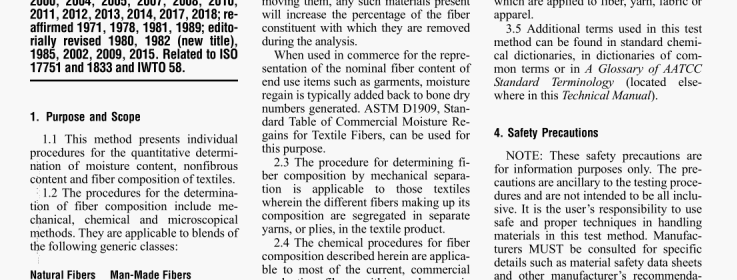Fiber Analysis

AATCC 20A-2018 pdf free.Fiber Analysis.
13.1 The following procedure may be used for the quantitative analysis of textiles containing two or more fiber types which cannot be separated readily by mechanical or chemical methods. The procedures rely on the ability of a technician to identify and count, by means of a microscope, the relative number of fibers of each type in a prepared specimen. Such a count will result in a percent blend by nu,n her of fibers. In order to convert this result to a percent by weight, the size of the fibers being counted and their respective densities must be included in the calculation.
13.2 Microscope slides may be prepared to scan longitudinal or cross-section views of a fiber sample. The fiber images may be viewed either through a microscope or as projected onto a horizontal plane. While either viewing method may be used for identification and counting of fibers, the projection method is specifically used for measuring fiber diameters using a wedge scale (see 14.3.2).
13.3 Methods which may be used to identify fibers during the fiber counting procedures are discussed in TM2O. Fiber
Analysis: Qualitative. They include the tillowing:It is recommended that reference tests be made on known fibers rather than placing total reliance on photographic reproductions and word descriptions of colors.
14.1.1 Longitudinal Sections of Vegetable Fibers (cotton, flax. ramie. etc.): A swatch of fabric measuring at least 5 x 5 cm should be available. Count the nwnbet of yarns in both the warp and filling and select from each direction at random a number of yams that is proportional to the fabric count. The combined number of warp and filling yams should total at least 20 (see 17.10). If the sample is in yarn fonn, take at least a two-meter length and, from it. cut not less than twenty 5-cm sections at random. Cut approximately 2.5 cm of each yarn. or yarn section. into lengths of 0.5.1 mm. The shorter the lengths the easier it is to prepare a homogeneous fiber suspension. Collect the cut fibers on a paper of contrasting color and transfer to a 125 mL Erlcnmeyer flask. Add sufficient water so that after stoppering the flask and shaking the contents, a uniform and fairly dense fiber suspension is obtained, Quick boiling or the addition of a few glass pellets facilitates the separation of the fibers. Using a glass-marking pencil, draw two parallel lines about I in. apart across a glass slide. With a wide-mouth pipette, draw 0.5-I mL of the well shaken suspension and place it between the two reference lines on the slide. The amount of liquid taken is dependent upon the density of the suspension. Just sufficient liquid should be placed on the slide so that -after evaporation—a thin, uniform film of fibers remains. After all of the moisture has evaporated from the slide, stain the fibers with Hcrzbcrg stain and cover with a cover glass.
14.1.2 Longitudinal Sections of Wool. Hair and other round Fibers: Select a represell tatis’e swatch, or yam sections. as in 14.1.1. With a fabric swatch, remove the outermost yarns in both directions so that the i’p and filling yarns are protruding approximately I cm. Lay the sample flat on a table and, using a fiber cutter, force the blades vertically downward into the warp fringe. Repeat the operation with the filling fringe. Remove the device with the top plate up, release the tension on the cutting bladcs and remove them together by their ends between the thumb and It is recommended that reference tests be made on known fibers rather than placing total reliance on photographic reproductions and word descriptions of colors.AATCC 20A pdf download.Fiber Analysis